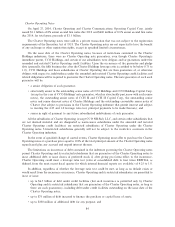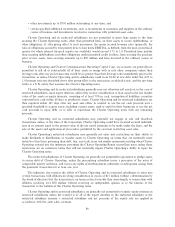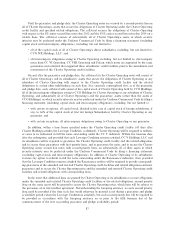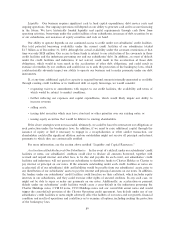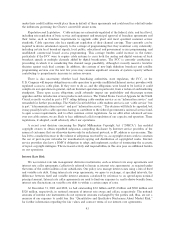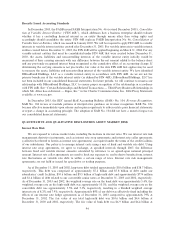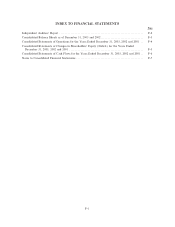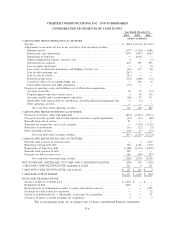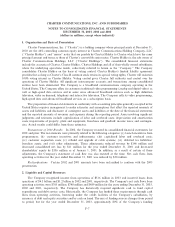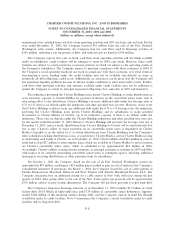Charter 2003 Annual Report Download - page 96
Download and view the complete annual report
Please find page 96 of the 2003 Charter annual report below. You can navigate through the pages in the report by either clicking on the pages listed below, or by using the keyword search tool below to find specific information within the annual report.Recently Issued Accounting Standards
In December 2003, the FASB issued FASB Interpretation No. 46 (revised December 2003), Consolida-
tion of Variable Interest Entities (""FIN 46R''), which addresses how a business enterprise should evaluate
whether it has a controlling Ñnancial interest in an entity through means other than voting rights and
accordingly should consolidate the entity. FIN 46R replaces FASB Interpretation No. 46, Consolidation of
Variable Interest Entities, which was issued in January 2003. We will be required to apply FIN 46R to variable
interests in variable interest entities created after December 31, 2003. For variable interests in variable interest
entities created before December 31, 2003, the FIN 46R will be applied beginning on March 31, 2004. For any
variable interest entities that must be consolidated under FIN 46R that were created before December 31,
2003, the assets, liabilities and noncontrolling interests of the variable interest entity initially would be
measured at their carrying amounts with any diÅerence between the net amount added to the balance sheet
and any previously recognized interest being recognized as the cumulative eÅect of an accounting change. If
determining the carrying amounts is not practicable, fair value at the date FIN 46R Ñrst applies may be used
to measure the assets, liabilities and noncontrolling interest of the variable interest entity. We have identiÑed
DBroadband Holdings, LLC as a variable interest entity in accordance with FIN 46R. As we are not the
primary beneÑciary of the variable interest entity (as deÑned by FIN 46R), DBroadband Holdings, LLC has
not been included in our consolidated Ñnancial statements. In future periods, we will continue to reassess our
relationship with DBroadband Holdings, LLC to ensure proper recognition of the relationship in accordance
with FIN 46R. See ""Certain Relationships and Related Transactions Ì Third Party Business Relationships in
which Mr. Allen has an Interest Ì Digeo, Inc.'' in the Charter Communications, Inc. 2004 Proxy Statement
available at www.sec.gov.
In December 2003, the SEC issued StaÅ Accounting Bulletin (SAB) No. 104, Revenue Recognition.
SAB No. 104 revises or rescinds portions of interpretative guidance on revenue recognition. SAB No. 104
became eÅective immediately upon release and requires registrants to either restate prior Ñnancial statements
or report a change in accounting principle. The adoption of SAB No. 104 did not have a material impact on
our consolidated Ñnancial statements.
QUANTITATIVE AND QUALITATIVE DISCLOSURES ABOUT MARKET RISK
Interest Rate Risk
We are exposed to various market risks, including Öuctuations in interest rates. We use interest rate risk
management derivative instruments, such as interest rate swap agreements and interest rate collar agreements
(collectively referred to herein as interest rate agreements) as required under the terms of the credit facilities
of our subsidiaries. Our policy is to manage interest costs using a mix of Ñxed and variable rate debt. Using
interest rate swap agreements, we agree to exchange, at speciÑed intervals through 2007, the diÅerence
between Ñxed and variable interest amounts calculated by reference to an agreed-upon notional principal
amount. Interest rate collar agreements are used to limit our exposure to, and to derive beneÑts from, interest
rate Öuctuations on variable rate debt to within a certain range of rates. Interest rate risk management
agreements are not held or issued for speculative or trading purposes.
As of December 31, 2003 and 2002, long-term debt totaled approximately $18.6 billion and $18.7 billion,
respectively. This debt was comprised of approximately $7.2 billion and $7.8 billion of debt under our
subsidiaries' credit facilities, $10.6 billion and $9.5 billion of high-yield debt and approximately $774 million
and $1.4 billion of debt related to our convertible senior notes at December 31, 2003 and 2002, respectively.
As of December 31, 2003 and 2002, the weighted average rate on the bank debt was approximately 5.4%, the
weighted average rate on the high-yield debt was approximately 10.3%, and the weighted average rate on the
convertible debt was approximately 5.5% and 5.3%, respectively, resulting in a blended weighted average
interest rate of 8.2% and 7.9%, respectively. Approximately 80% of our debt was eÅectively Ñxed including the
eÅects of our interest rate hedge agreements as of December 31, 2003 compared to approximately 79% at
December 31, 2002. The fair value of our total high-yield debt was $10.6 billion and $4.4 billion at
December 31, 2003 and 2002, respectively. The fair value of bank debt was $6.9 billion and $6.4 billion at
94


